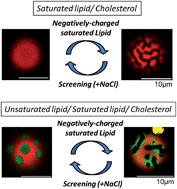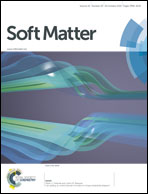Charge-induced phase separation in lipid membranes
Abstract
Phase separation in lipid bilayers that include negatively charged lipids is examined experimentally. We observed phase-separated structures and determined the membrane miscibility temperatures in several binary and ternary lipid mixtures of unsaturated neutral lipid, dioleoylphosphatidylcholine (DOPC), saturated neutral lipid, dipalmitoylphosphatidylcholine (DPPC), unsaturated charged lipid, dioleoylphosphatidylglycerol (DOPG(−)), saturated charged lipid, dipalmitoylphosphatidylglycerol (DPPG(−)), and cholesterol. In binary mixtures of saturated and unsaturated charged lipids, the combination of the charged head with the saturation of the hydrocarbon tail is a dominant factor in the stability of membrane phase separation. DPPG(−) enhances phase separation, while DOPG(−) suppresses it. Furthermore, the addition of DPPG(−) to a binary mixture of DPPC/cholesterol induces phase separation between DPPG(−)-rich and cholesterol-rich phases. This indicates that cholesterol localization depends strongly on the electric charge on the hydrophilic head group rather than on the ordering of the hydrocarbon tails. Finally, when DPPG(−) was added to a neutral ternary system of DOPC/DPPC/cholesterol (a conventional model of membrane rafts), a three-phase coexistence was produced. We conclude by discussing some qualitative features of the phase behaviour in charged membranes using a free energy approach.


 Please wait while we load your content...
Please wait while we load your content...